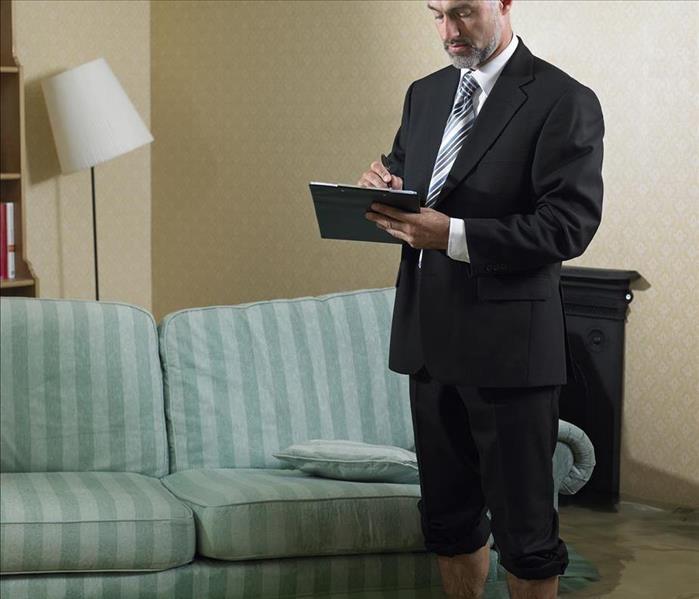Are Flood Losses Expensive for Homeowners?
10/21/2020 (Permalink)
SERVPRO Works with your Insurance Adjuster to Make Sure your Northampton Home Returns to a Pre-incident Condition After Flood Damage.
How do homeowners deal with flooding?
Flooding in Northampton can be a massively traumatic event for homeowners. Not only is the home unsafe, but there is also a risk of losing possessions that may have been collected over a lifetime. We understand that the best method for dealing with a traumatic event is to perform effective and efficient restoration for homeowners. Our technicians have extensive experience dealing with flood losses, which allows us to answer tough questions like where to store contents, prevent further damage, and return a home to its preloss condition correctly. Our crew chiefs or project managers are on-hand to communicate with you directly and ease any concerns you may have about the home's structure or possessions. Our guidance can help you reduce the burden of worry that so frequently afflicts homeowners undergoing flood recovery. That is why we operate our call lines twenty-four hours a day and promise to arrive at your property within four hours of notification of loss to begin work, whenever possible.
How necessary is preparation for flood recovery?
To reduce the impact of flood damage in your Northampton home, it is essential to come prepared. As a homeowner in a flood-risk area, it is wise to take out a separate flood insurance policy, create a flood preparedness kit, and a game plan should a flooding event be imminent. SERVPRO is equally prepared by establishing a fail-safe, tried, and tested method for restoration and mitigation of loss in your property. A crew chief conducts a detailed pre-inspection of your property upon arrival at the site to note any areas where there is potential for loss reduction. Loss reduction could be extracting water or providing humidity control. Crew chiefs also document the number of technicians needed and the type of equipment we require to perform our jobs. Our preparation spans back to our training, experience working on residential properties, and advanced cleaning or drying equipment.
What are the priorities for mitigating losses in a flooded home?
- Protecting the structure from unlawful entry, looting, or trespass and noting potential hazards within the structure like falling ceilings, damaged subfloors, or exposed wiring.
- Pumping out the standing water from the home which can help to reduce the pressure on walls and joints as well as significantly reducing the impact of water exposure on contents.
- Inspecting cavities where water may have migrated, such as crawlspaces, subfloors, and wall voids.
Can floodwaters be pumped out entirely from a property?
While pumps may be the most efficient method of extracting water from a property, these are only useful for reducing standing water levels. Once the water level drops to below two inches, there is a no-longer adequate lift for pumps to remove moisture. SERVPRO technicians resort to extraction equipment to remove residual moisture from home. First, we use a moisture meter to find out the level of water penetration in the material. Contents in the house can be blocked, secure them from water exposure, or taken to a dry, clean area of the home to reduce further damage. To guarantee that our extraction process eliminates of all residual moisture in the affected area, we often remove floor finishes like hardwoods, carpets, and laminate flooring. Getting rid of water efficiently goes a long way to mitigating losses in your property, allowing you to return sooner.
How are surfaces returned to a normal condition after flooding?
- Application of deodorizer or anti-microbial chemicals directly onto the surfaces reduces the chances of malodor or secondary losses.
- Removing the spots and stains from furnishings or upholstery while these contents are wet to ensure stains do not become permanent.
- Applying specific topical treatments to distinctive textiles like carpets or high-value upholstery such as leather and satin.
How do professional restorers dry a property?
Drying the property after a water intrusion event is essential to ensuring that your home does not suffer further losses. Much microbial growth in the house is the result of a recent water intrusion event. SERVPRO brings in humidity controls alongside air-moving equipment to thoroughly dry the property and prevent microbial spores from growing in the environment. Professional drying of the home can also help control odors, which are more perceptible in a wet climate. Our technicians regularly monitor a property throughout the restoration to ensure drying is effective and correlates with our expected timeline.
How are drying equipment combined to improve drying time?
- Air movers are positioned throughout the property to evaporate moisture using heat and ventilation.
- Dehumidifiers, either refrigerant or desiccant, can help to draw the evaporated moisture out of the air and prevent indoor humidity from rising.
- Indoor furnaces can help to provide additional temperature to aid moisture removal.
Flooding can be extremely difficult to overcome without the assistance of qualified restorers. Contact SERVPRO of Hampshire County at (413) 324-5400.






 24/7 Emergency Service
24/7 Emergency Service
